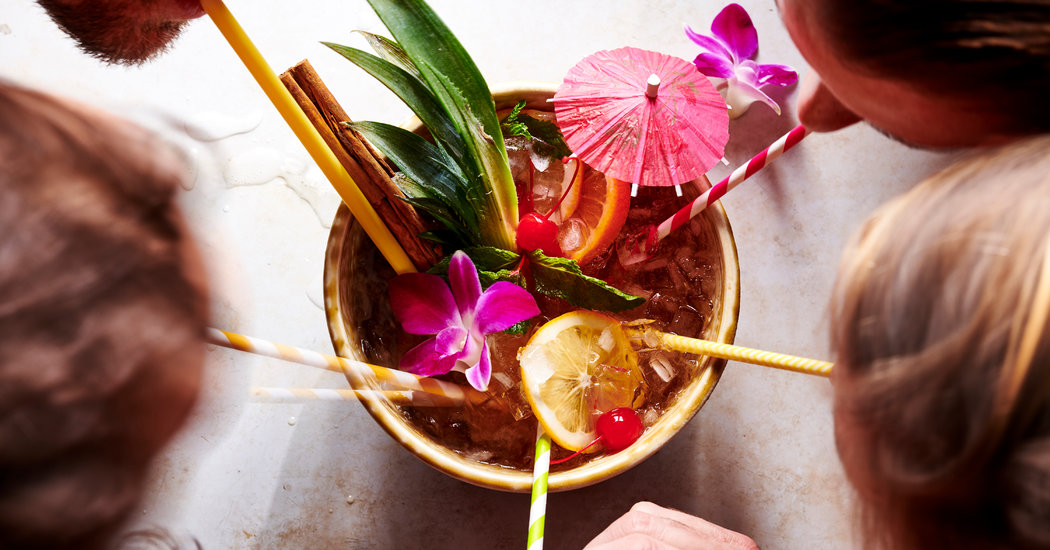
The reasons we drink may vary, whether it’s to connect, to forget, to end a workday or to open an evening.
With tiki cocktails, however, the reason bubbles straight to the surface: It’s to have fun.
Mai tais, zombies and fog cutters do the trick. But the scorpion bowl, group-friendly and potent, takes tiki’s night out to boisterous levels. It is unlike anything else.
“It’s 100 percent fun,” said Julie Reiner, owner of the Brooklyn bars Clover Club and Leyenda. “Nothing makes somebody happier than a drink that comes to you on fire with crazy garnishes and a whole bunch of straws.”
The scorpion bowl, a mix of rum, gin and Cognac served in a large ceramic bowl, is an oversize, boozy paradigm of excess. If the mai tai is a good Saturday night out at the bar, the scorpion bowl is an exuberant party thrown by four drag queens during Pride Month.
Created with communal drinking in mind, scorpion bowls are a product of tiki, a cultural craze that began in the 1930s and was the brainchild of Ernest Raymond Beaumont Gantt. Better known as Donn Beach, he was a frequent traveler to islands in the Caribbean and the South Pacific, eventually landing in Los Angeles.
His first Hollywood bar and restaurant, Don the Beachcomber, provided a reprieve from reality and placed diners in a romanticized Polynesian setting, with powerful, multilayered rum cocktails at the center. The idea was that you would enter Don the Beachcomber and “feel like you’re in any one of these islands,” Ms. Reiner said.
Copycat tiki bars soon followed, including Trader Vic’s in Oakland, Calif., whose owner, Victor Bergeron, is largely credited with creating the scorpion bowl.
A current of secrecy ran directly underneath tiki’s elaborate garnishes and escapism. Bartenders, rightfully afraid that others would steal their ideas, kept their recipes “under lock and key,” said Shannon Mustipher, a bartender in Brooklyn and the author of the recent cookbook “Tiki: Modern Tropical Cocktails” (Rizzoli, 2019).
“They were coded so that even if a bartender wanted to go to another establishment, they didn’t know what was actually in the drink,” she said.
This is why so many variations of classic tiki drinks exist — and why it’s hard to pin down the original recipes. But, according to Ms. Mustipher, a scorpion bowl should involve dark Jamaican rum, cognac, gin, citrus and orgeat.
Orgeat, a sweet almond syrup often perfumed with orange-flower water, is essential in rounding out the layers of hard booze. A good orgeat, subtly nutty and aromatic, smooths the scorpion bowl’s sharp edges. A lesser one amplifies the fun-house vibes and steers the final drink artificially sweet. Both Ms. Mustipher and Ms. Reiner suggest looking for a higher-quality option online or making your own.
While quality ingredients are central to any superior cocktail, the scorpion bowl’s success hinges on the final garnish. Outfit your bowl in orchids, citrus peels, pineapple wedges, silly straws, fire. Whatever your garnish, choose a gluttonous path.
“The goal is that when you bring it out, people’s eyes get wide and their mouths open, and they want to clap for the drink,” Ms. Reiner said.
The bowl itself can be a classic volcano dish decked with palm trees and hula skirts, but it doesn’t need to be. Smaller soup tureens or that punch bowl collecting dust in your top cabinet work just as well. Banish thoughts of individual glassware, and turn your attention to reusable metal or outrageously patterned paper straws.
Finally, pick your companions wisely. You should either know and love the people you’re drinking with, or be willing to get there fast. You’ll be sharing, photographing, crashing heads together and forgetting whose straw is whose all night. Improvise a toast, light something (carefully) on fire, repurpose garnishes as outfit enhancers — in other words, let the evening be a raucous tribute to joy.




